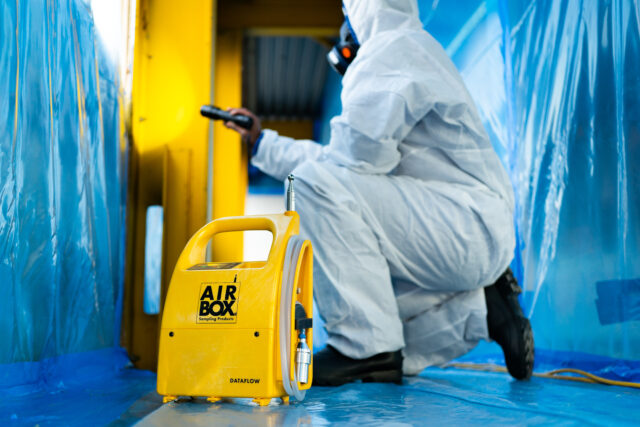The number of public buildings with confirmed reinforced autoclaved aerated concrete (RAAC) is growing in the UK, affecting key community buildings like hospitals as well as schools. At the last count, 174 schools were confirmed with RAAC.
Unfortunately, the peak use of RAAC coincided with the use of asbestos containing products, particularly in school buildings. Asbestos can be harmful to health when disturbed (see below: Why is asbestos dangerous?), including during any process to remove RAAC. Asbestos air sampling is a simple process for managing asbestos risk, helping to ensure the safety of a building during and after remedial work.
Asbestos and RAAC can coexist complicating remedial works
RAAC was a popular material in the period from the 1950s to the 1990s. Cheap, light, with good thermal properties and easy to shape, it lent itself to public building use, particularly as slabs for flat roofed buildings. RAAC does not contain asbestos, but the plasterboard, textured paint and other materials used around RAAC planks and slabs can contain the material.
Stuart explains: “The heyday for RAAC and asbestos coincided, leaving us with a dangerous legacy to deal with. Measures to assess the presence of RAAC, or work to remove the material, has the potential to disturb any asbestos present and release its tiny fibres into the air. Inhaling these fibres can pose serious health risks for construction workers and building users, even post remedial work.”
Schools: At the centre of the RAAC and asbestos storm
A 2023 report by the National Audit Office (NAO) estimated that 24,000 school buildings (38% of the total) are beyond their design life. Nearly two-thirds (13,800) of these are ‘system-built’ buildings and, according to the NAO, ‘almost all’ contain asbestos. It follows that schools blighted with RAAC may also need to deal with asbestos.
“The message from the Government to schools is ‘check for RAAC’ but this needs to be carried out in a way that minimises any additional risks, including those presented by asbestos. It’s important that a suitably qualified person carries out these checks,” says Stuart.
The UK Government has published detailed guidance for schools about how to manage asbestos, while the Institute of Structural Engineers has produced authoritative advice for managing RAAC. Stuart says it is ‘vital that the risk management of these two materials is aligned’.
How air sampling for asbestos reduces health risk

Air sampling for asbestos is carried out when there is a risk of asbestos fibres becoming airborne, for example, during building works where asbestos might be present, or for the removal of known asbestos material.
The process involves drawing a known volume of air through a filter over a measured period of time. The filter is then examined under a microscope and the volume and size of asbestos fibres assessed.
Air sampling for asbestos helps to ensure the safe management of the material and creates a valuable data resource. Here are some of the benefits that air testing for asbestos offers:
- Confirmation that an appropriate level of personal protection equipment (PPE), including respiratory protective equipment (RPE), has been chosen.
- Checking the effectiveness of dust suppression methods used during the asbestos removal process
- Providing essential data for employee exposure records
- Fulfilling one of the four stages towards acquiring a Clearance Certificate which determines that the levels of asbestos fibres are safe for occupation
- Use of the tool is a requirement for the licensed removal of asbestos
Stuart says higher volume air sampling for asbestos, which samples more air over an extended run time, is fast becoming the industry norm as safety standards rise: “In recent years, the industry standard has been for 3-5 litres of air to be measured per minute. But clients are demanding ever higher standards, and the technology to enable this is advancing.
“Airbox’s Variflow XL air sampling pump exceeds all industry standards with its capacity of delivering a run time of up to 10 hours at 16 litres per minute. The benefit is a more detailed and accurate assessment of asbestos in a specific space, whether interior or exterior, allowing precision management of any risk.”
By using specialist tools that help to manage asbestos health risks, any delays to RAAC remedial work can be minimised – and disruption to essential public services and education can be reduced.
- For more information about Airbox Sampling Products, please visit com
Why is asbestos dangerous?
Asbestos is a naturally occurring material that contains tiny fibres that can become airborne, especially if disturbed. They can then be inhaled, and cause serious diseases such as mesothelioma, asbestos-related lung cancer, asbestosis and pleural thickening. These diseases can take years to develop. By the time they are diagnosed, they can be life threatening.




